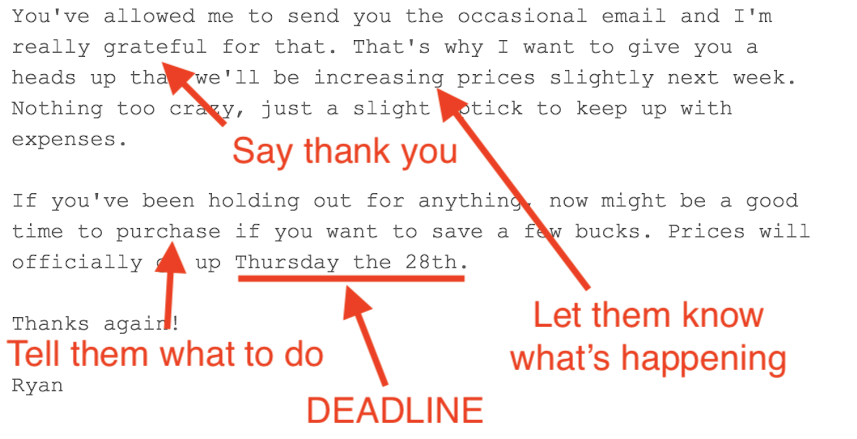How To Raise Prices In 6 Steps (& keep our customers happy!)


It’s practically a law of the entrepreneurship universe: if you’re a beginning entrepreneur, you’re going to undercharge.
You can barely believe people are paying you to begin with. So, you charge as little as you possibly can, almost as a way of apologizing for the gross imposition of asking for money in the first place.
And you know what? That’s okay! This is a law of the universe for a reason: because it’s something that a ton of entrepreneurs go through as they’re navigating the tricky (and uncharted) waters of how much they’re worth — and how much their audience is willing and able to pay.
And since most entrepreneurs undercharge, most entrepreneurs eventually realize: the math doesn’t work out. You’re working all these hours coaching and community-building and doing customer support, and somehow you’re managing to lose money instead of gaining it — and lose control of your time, instead of gaining that.
And that means one thing: it’s time to raise your prices. Here’s how to do it.
1. Add value to your product
One of the best ways to smooth out the process of asking your customers for more value: giving more value in return.
If you announce that a package of coaching sessions that used to cost $100 per hour now suddenly costs $300, sure, people are going to have questions. Why is time with you NOW suddenly worth more than it was three weeks ago?
If you explain that that $300 coaching package now comes with a workbook AND three video modules AND access to a community on Slack on the other hand? Suddenly that $300 starts to feel like a pretty good deal.
This takes advantage of a useful (but unfortunately named) marketing concept known as “pricing confusion.” People have an idea of what the “going rate” is for an e-book or an hour of consulting. It’s easy for them to eyeball what you’re charging and measure it up against prices they’ve seen elsewhere. But when you’re selling coaching AND coursework AND community? Suddenly that comparison no longer holds up.
It’s not about pulling a fast one on customers (this is why the term “pricing confusion” drives me nuts). It’s about under-promising and over-delivering: giving people way more value than what they expect to get from a service like the one you’re offering — and then asking for slightly more value in return.
2. Choose your moment wisely
When people are making buying decisions, they’re basically doing a math equation in their head: “Which is greater: my desire to get this product/course/coaching, or my desire to not spend money?”
If a resource is scarce (like the opportunity to work with you), or an outcome they want is time sensitive (like dropping a few pounds before bikini season), it changes that calculus and tilts things toward the “buy” side of the scale. If you choose your moment wisely, you can use that to your advantage.
3. Give fair warning
Once you choose your moment for your price increase, the next step is to give your audience plenty of warning of what’s about to happen.
Plan to send an email to your list alerting them of the coming price hike about a month before it takes effect (being sure to include the exact date the new price kicks in). Then, add a P.S. to emails as the deadline gets closer — three weeks, two weeks, and one week in advance.
With enough advanced warning, no one can say they didn’t see it coming — and it gives them a chance to get used to the idea.

4. Offer a chance to get in before prices go up
Once you announce that your prices are going up, give people an opportunity to react to the news by buying now, at the old price, if that’s what they want to do.
An added bonus to keeping the window open for people to get in before prices go up: it can be a good way to bring in a wave of sales quickly. Nothing like an impending price increase to spark FOMO and nudge fence-sitters off their perch.

5. Test your message
The variable sitting in the middle of the decision to raise prices is, “How will my followers react?”
One way to test the waters: send your announcement to a smaller group of customers before you flip the switch on a huge email blast.
Start with people you know are happy with you and your product — your most engaged, email subscribers, or that coaching client you know is getting results from the work they’re doing with you. If something in how you frame the price increase raises red flags with that test audience, adjust it before sending to your broader list.
6. Take the leap, because you’re worth it
Raising prices is one of those subjects that you can obsess and obsess over if you let yourself. At a certain point, you just have to rip off the Band-Aid and do the thing.
Three money mindsets from our course Zero to Launch to keep in mind when you do:
#1: “People pay me for the value I create.” If you say “I charge $500 for this product,” and customers say, “Okay,” that’s not a fluke. That’s them agreeing that that is a reasonable price for what you offer.
#2: “The more I make, the more value I can create.” The money you earn when you raise your prices is money that you can put back into your business, to create more awesome things that will be useful and valuable to your customers.
#3: “Money is a marker that I'm doing the right thing.” If people are paying you, it’s because they like you, and they like what you’ve done for them. You’re doing something right. Don’t question that — celebrate it. And keep going.